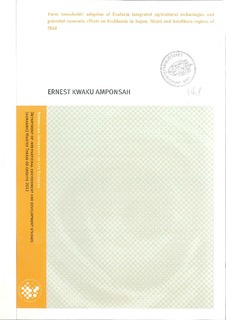| dc.description.abstract | ABSTRACT
Food production among the majority of agro-pastoral households in rural Mali are hampered by low rainfall, infertile soil, and extreme poverty. To improve productivity and enhance livelihood, the Drylands Coordination Group implemented the project Ecofarm on the farmers’ field from the year 2004 to 2008 with technical assistance from the Department of International Environment and Development Studies (NORAGRIC) at Norwegian University of Life Sciences. The project tests the ability of low cost technologies to increase productivity and income in order to help poor farmers achieve a better livelihood. This study assessed the degree of Ecofarm technology adoption, identified the reasons for adoption, and investigated the impact of adoption on the livelihoods.
The study was carried out in the regions of Segou, Mopti and Koulikoro of Mali. Cross-sectional surveys were carried out in 12 randomly selected villages from the three regions in which 120 household heads were selected. A semi-structured questionnaire and interviews were applied to collect quantitative and qualitative data from household heads. Interviews with local and international NGOs were carried out using a Snowball sampling approach.
Results indicate that a wide range of technologies have been disseminated in the surveyed area by NGOs, but the Ecofarm technologies were the most adopted. The result shows that microdosin, the application of 0.3grams of fertilizer in the planting pocket simultaneously with sowing or 15 to 20 days after cultivation; is adopted by 68.1% of the household. While there are about 51.3% farmers adopting seed priming; the soaking of seed or grain in water before cultivation. The cross tabulation result indicates a variation in gender adoption of microdosing and seed priming. About 70.2% of men adopted microdosing while 61.1% women of women adopted microdsoing. Yet a chi square result shows no significant association between gender and adoption of microdosing technology. From the focus group discussion, it emerged that women adopt less of fertilizer microdosing technology as compared to seed priming because of the workload attached.
Results show increased crop yield with the application of fertilizer microdosing across regions. In Segou, average quantity of millet increased from 240 kg per hectare using traditional practices to 855 kg per hectare with microdosing technology. Sorghum yield increased from 260 kg using traditional practices to 805 kg per hectare using microdosing technology in Segou. In Mopti millet and sorghum, yield increased from 125 kg and 155 kg per hectare using traditional practices, to 500 kg and 430 kg per hectare respectively with microdosing technology.
The gross output results show that the project has contributed to increasing farmers’ income. In Koulikoro, microdosing of millet gave farmers a net benefit of 159508fcfa per hectare as compared to 1708fcfa using traditional practices. In Segou, microdosing of millet gave a net benefit of 144837fcfa as compared to 37974fcfa using traditional practices. While in Mopti, microdosing of millet gave farmers a net benefit of 81363 fcfa per hectare as compared to 21000fcfa using traditional practices. With sorghum, farmers who applied microdosing technology recorded an impressive net benefit of about 175087fcfa per hectare in Segou as compared to 54974fcfa using traditional practices. While those in Mopti and Koulikoro recorded a net benefit of 88863fcfa and 42259fcfa per hectare with microdosing technology, respectively as compared to 34750fcfa and 37708fcfa using traditional practices respectively.
Land size owned was one of the major determinants of the quantity of fertilizer use (adoption). The result indicates that the adoption of microdosing continues to increase with land size until it reaches a point where it starts decreasing. Similar trend was observed across regions. In Segou, average land owned by a framer was 18.1 hectares. Yet, just 1.1 hectares were used for microdosing as compared to Mopti and Koulikoro where average land size owned was 11.8 hectares and 4.9 hectares respectively, yet 4.8 hectares and 2.2 respectively were used for fertilizer microdosing technology.
Livestock fattening technology; tying of livestock to a tree or stick and feeding them with the leftover of cowpea and leaves, accelerated growth of livestock and increased income of the farmers. A sheep bought at a price of 23.000fcfa is sold for 55.000fcfa within 6 months in Segou if fattening technology is practiced. The same amount spent on the same livestock generates an average of about 60.000fcfa and 65.000fcfa in Mopti and Koulikoro, respectively. The number of trees planted on farmers field has dramatically increased. In Segou, each farmer has planted an average 122.2 trees, while those in Mopti and Koulikoro has planted an average of about 105,8 and 99.9 trees respectively in the surveyed areas.
The simple linear regressions result shows that a number of dependants’ variable was positively and significantly related with adoption while variables such as distance to fertilizer, land size and prices of fertilizer used in the regression show a negative significant relationship with adoption. However, when all the above mentioned variables were put in a multiple regression, only distance to fertilizer showed a positive significant relationship with adoption.
Testimonies from the village of Dafara indicate that feeding on Moringa powder for a three month period increased the breast milk of a mother and contributed to an improvement in the health of a previously sick child. Moreover, adding Moringa powder to the diet improved the men potency. The survey and the common impression from farmers’ testimonies is that those who adopted Ecofarm technologies experienced reduction in months of food insecurity, increased income, better health and nutrition and a general improvement in livelihood. Focus group discussion showed that the project has contributed to increased input outlets. Cross tabulation analyses of response from the 12 villages indicate that the Ecofarm technologies have been scaled up into about 51 villages.
The multiple regression result suggests a need for strengthening fertilizer outlet for a majority of farmers to adopt microdosing technology. Information dissemination by NGOs to farmers concerning seed preservation after soaking in water has also been indicated. | no_NO |
